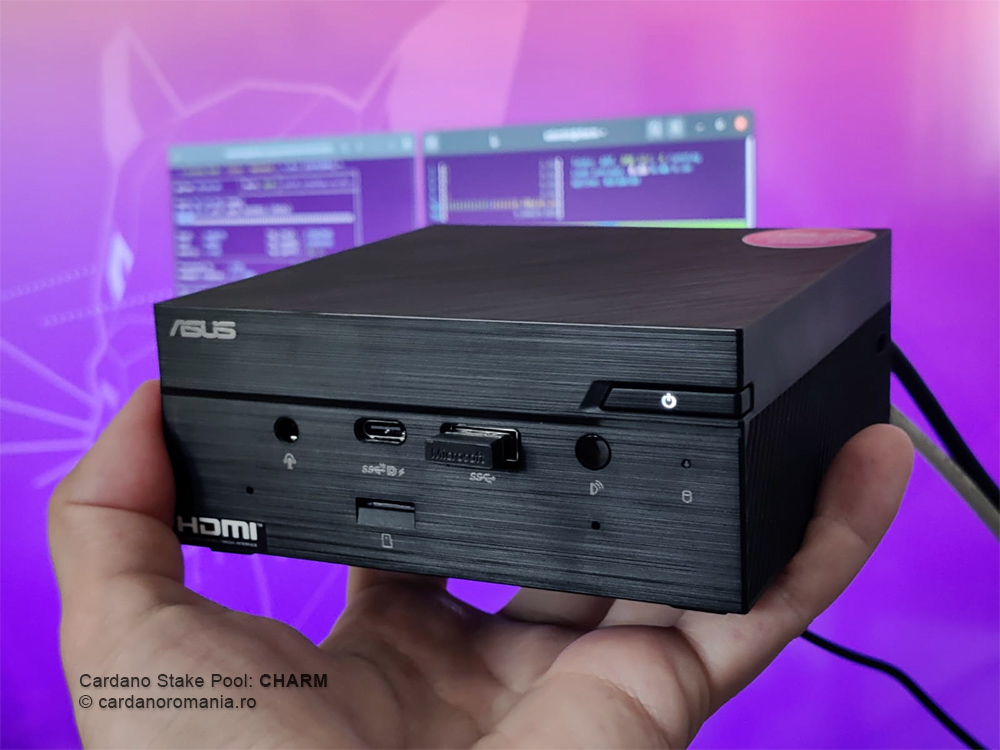As you know, our team manages the Cardano pool with the ticker CHARM. We have been involved in this since the test net in the fall of 2019.
From the beginning, we set out to contribute as much as possible to the decentralization of the Cardano network, using our own servers.
Until recently, our pool operated in a configuration composed of a main server and a back-up server, where on each server were installed several virtual machines for both the core node and the 2 relays.
A month ago we decided to change the architecture of the pool to reduce both power consumption and server space. To simplify things even more, we gave up virtual machines, which also used a lot of resources.
For this we decided to replace the old servers with new ones of “mini PC” type. After a lot of research I found the ASUS PN50 model with AMD RYZEN 4300U processor. The experience of the last year has shown us that the software on which the Cardano node runs is not dependent on the performance of the processor. Benchmarks show that the AMD RYZEN 4300U is not a weak processor at all, which is why we thought that this quad-core processor is more than enough for our Cardano node.

More details on the performance of the AMD Ryzen 3 4300U processor can be found on cpubenchmark.net

ASUS PN50 mini PC measures only 115mm x 115mm x 49mm, ideal dimensions for this task.

The ASUS PN50 mini-PC comes without memory and without an SSD. To complete it, I chose a HyperX Impact Notebook Memory Kit, 16GB, DDR4, 2666MHz, CL15, 1.2v, Dual Channel Kit and a GIGABYTE 256GB PCI Express 3.0 x4 M.2 2280 SSD.


The new configuration of our pool consists of three separate servers, a core node and two relays. In case of a failure of one of the servers, the other two will be able to keep the pool functional until the problem is fixed. Even if two of the three servers fall, the third one could keep the pool online. But the most important aspect is the reduction of energy consumption. If we follow the user manual, an ASUS PN50 with RYZEN 4300U processor has a consumption of only 10W per idle and taking into account the fact that the processor has a occupancy rate of less than 10%, we thought that the actual consumption of this mini-pc is not far from this value.
To test it I used a “smart” socket that can display consumption in real time and the result was amazing. When booting Linux Ubuntu Server 20.04, the consumption is 12-13W. When synchronizing the node, the consumption is 19-20W. After synchronization, the consumption drops and remains somewhere between 7W and 9W, which exceeded all expectations.

In terms of the hardware resources of the new server, the image below speaks for itself. On the left you see the load / core - it’s normally well below half the displayed values, but because I moved the mouse to take the screenshot, the values have increased to the ones you see.

During operation you can only hear it if you stick your ear to it. The measured temperature is ~31° C or ~89° F

After almost a month of relay testing, the new mini-server now functions as a core node. On the other 2 “old” systems, a relay runs on each one. In the coming days, they will also be replaced with ASUS PN50 in identical configuration.
If you want to support us by also contributing to the decentralization of the Cardano platform, you can delegate ADA coins from Daedalus or Yoroi to our pool with the ticker CHARM.
More details about ASUS PN50 can be found on the manufacturer’s page: Mini PC PN50|Mini PCs|ASUS Global
